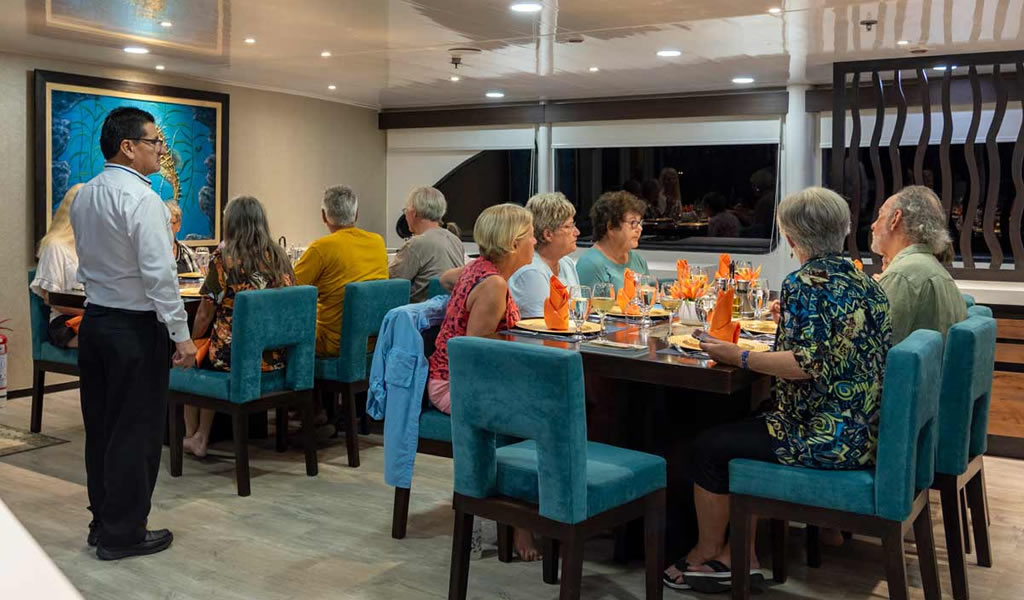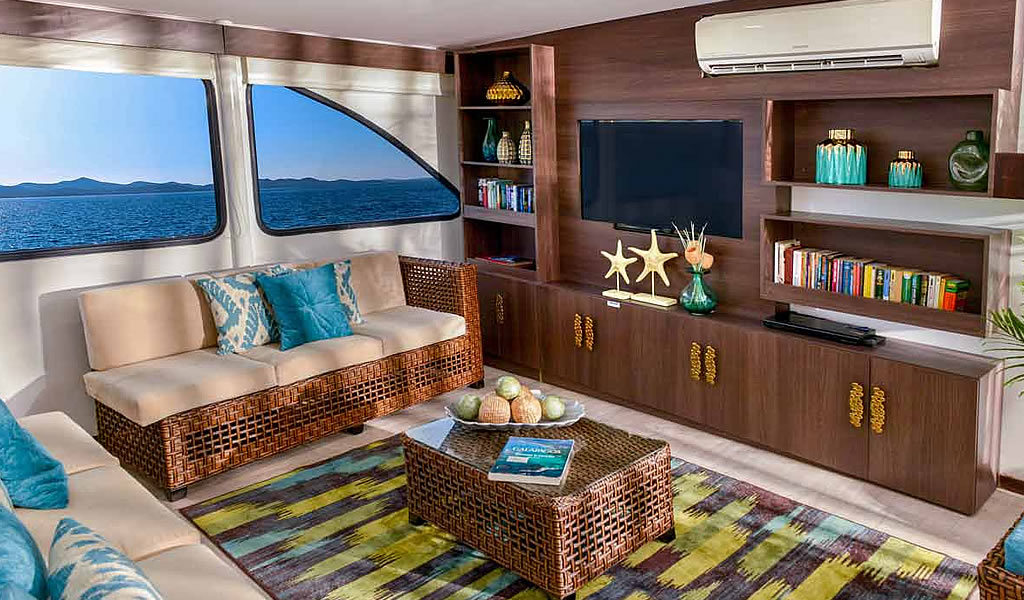Show Detailed Itinerary
Day 01
Am: San Cristobal AirportDeparture to the Galapagos Islands, arrival at San Cristobal airport, where our naturalist guide of the National Park will be waiting for you.
Pm: Lobos IslandLobos island is a small islet separated from San Cristobal by a narrow channel, forming a sheltered bay where sea lion pups play in tidal pools. Despite its small size, the island is surprisingly packed with wildlife, especially with “lobos marinos”, the Spanish name for sea lions. Groups of sea lions will welcome you at the landing spot, but as you walk a few steps inland, male frigatebirds displaying their inflated red balloons will be perched on the bushes and trees. A small colony of blue footed boobies, which often nest right on the trail, will give you the opportunity to observe their famous courtship dance.
Snorkel: This is a great snorkeling location as the water are usually calm and the sea lions often play with divers to show off their swimming skills. Sea turtles and rays are often seen resting in the sandy bottoms.
Highlights: Galapagos sea lions, marine Iguanas, magnificent & great frigatebirds, blue-footed Boobies, San Cristobal Lava Lizards.
Trail: 0,6 km
Meals: Lunch, Dinner
Day 02
Am: Santa FeGiant Prickly-pear cactus and barren lava rocks surround the landing spot at Santa Fe, located inside one of the most beautiful bays in the Galapagos. Turquoise water and white sand beaches make this location a perfect home for a large colony of sea lions which you will see basking in the sand. Inland, look down for endemic Santa Fe land iguanas, but also look up for Galapagos hawks, which often perch at the top of the cactus looking for prey. Darwin finches, Galapagos doves, mockingbirds and lava lizards are also common along the trail.
Snorkel: After the hike, you will have the option to kayak or snorkel in the sheltered waters inside the bay, where you can swim with sea lion pups and reef sharks. Also look for sea turtles, rays and a large variety of tropical fish including large schools of surgeonfish and parrotfish.
Highlights: Giant cactus, Santa Fe bay, Galapagos sea lions, Santa Fe land iguanas, Galapagos hawks, Galapagos doves, reef sharks.
Pm: PlazasOf the two twin islands, only South Plazas is allowed to be visited, while North plazas is kept exclusively for scientific research. This is a small islet, but it packs an impressive amount of wildlife. Right after you land you will see Galapagos land iguanas waiting under prickly-pear cactus feed on their fruits. A large colony of sea lions will give you the opportunity to see playful pups enjoying the tide pools, but also large grumpy males defending their territories. The trail will take you to a cliff where you can observe many sea birds, such as frigatebirds, red-billed tropicbirds, boobies, swallow-tailed gulls and pelicans. A reddish succulent vegetation with scattered cactus covers most of the islands like a carpet, giving this island a unique personality.
Highlights: Galapagos land iguanas, sea lions, tropicbirds, pelicans, boobies, Galapagos shearwaters, swallow-tailed gulls.
Trail: 1,4 km / 0,8 mi
Meals: Breakfast, Lunch, Dinner
Day 03
Am: SeymourThis island is home for large colonies of both magnificent and great frigatebirds and you can see them displaying their red balloons to attract a female. Blue-footed boobies nest in the ground and perform their famous dance in the open areas, while swallow-tailed gulls perch on the cliff edges. Land iguanas are common inland while their marine cousins bask in the rocks by the sea, close to sea lions, which often like to body surf in the waves.
Snorkel: This place is a really great snorkeling location, as it has tremendous diversity and amount of fish, but also sea lions, sharks, eels, turtles, rays and many more.
Highlights: Galapagos sea lions, blue footed boobies, magnificent & great frigatebirds, land & marine iguanas, swallow-tailed gulls, shearwaters, Darwin finches.
Pm: MosqueraMosquera is mostly a barren sand bar with some rocky areas and scattered salt-resistant plants. You can walk along the beach and enjoy seeing playful sea lion pups surfing the waves and having a great time in the tide pools. Look for endemic lava gulls which are often seen flying over the beach in the search of food.
Snorkel: If the waves are not too big you can snorkel at the northern tip of the island or at one of the small beaches in the sheltered side.
Highlights: Galapagos sea lions, lava gulls, oystercatchers, shorebirds.
Trail: There is no trail, but you can walk along a sandy area of 0,6 km / 0,4mi
Meals: Breakfast, Lunch, Dinner
Day 04
Am: Darwin BayGenovesa is a favorite island for birdwatchers as it is home for very large colonies of seabirds. From the minute you set foot at the beach you will be amazed by the noise of hundreds of boobies, gulls and frigatebirds flying over your heads, perched in the bushes or nesting on the sandy terrain. The trail is an ultimate wildlife experience as there are animals everywhere; sea lions and marine iguanas near the sea; night herons, lava & swallow tailed gulls, Darwin finches, Galapagos doves, mockingbirds and many more species inland.
Snorkel: The bay offers several places to snorkel; from deep waters along the cliffs across the bay, to shallow waters by the beach. In either case, there are many fish to see and great chances of seeing sharks, rays and sea lions.
Highlights: Nesting great frigatebirds, red footed & Nazca boobies, Galapagos sea lions, lava & swallow-tailed gulls, yellow-crown night herons, Genovesa ground finch, Genovesa cactus finch, Galapagos mockingbirds.
Pm: El BarrancoEl Barranco is located in the southern part of Darwin Bay at Genovesa Island. The cliffs face the sea are made of very fragile fractured lava, making it the ideal place for storm petrel to build their colonies, which attracts an important population of short-eared owls preying of the nesting birds. Red footed and Nazca boobies are abundant along the trail. At the base of the cliffs you can see Galapagos fur seals resting in shaded areas, as well as several species of seabirds.
Snorkel: You can snorkel along the cliffs where there are many fish and great chances of seeing sharks, rays and sea lions.
Highlights: Nesting great frigatebirds, red footed & Nazca boobies, Galapagos sea lions, Galapagos fur seals, lava & swallow-tailed gulls, yellow-crown night herons, Genovesa ground finch, Genovesa cactus finch, Galapagos mockingbirds.
Trail: 1,2 km / 0,7 mi
Meals: Breakfast, Lunch, Dinner
Day 05
Am: HighlandsEither if you do this visit starting from Baltra or from Puerto Ayora, a bus will take you to the highlands stopping along the way at one of the reserves to visit the lush highland forests where you will look for Galapagos Giant tortoises in their natural environment. This is the best place in the Galapagos to see these gentle giants (reaching over 300 kg / 600 pounds!) casually grazing and resting in freshwater ponds. This is also home for a great diversity of birds rarely found at the lowlands, including finches (tree, woodpecker and vegetarian finches), flycatchers and several species of water birds. You will visit a lava tunnel (depend on the itinerary) and learn how these extraordinary formations where created by ancient volcanic eruptions.
Highlights: Giant tortoises, Darwin finches, barn owls, white-cheeked pintails, Galapagos flycatchers, Lava tunnels.
Trail: 1-1,5 km
Then, transfer to the airport to take your flight back to continental Ecuador.







